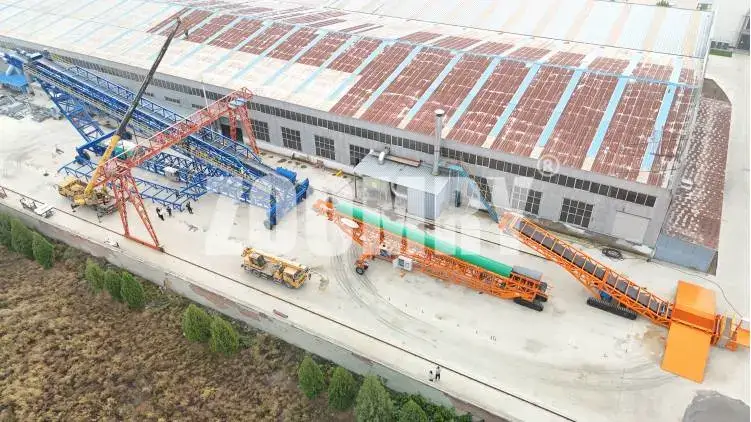Time:2025-05-01 09:15:48 Number of Clicks:
Amid the global trend of industrial energy conservation, optimizing energy efficiency of bulk material handling equipment has become a key focus for mining, port, and power industries. According to IBTA statistics (2023), global industrial energy waste in material handling reached $5.8 billion, with 32% attributable to inefficient equipment.
With over 20 years of expertise, ZOOMRY Heavy Industry has reduced per-ton energy consumption from 0.82kWh to 0.48kWh through drive system and control algorithm innovations, equivalent to saving 23,000 liters of diesel annually. This breakthrough demonstrates that energy optimization requires systemic reconstruction across power transmission, operational logic, structural mechanics, and maintenance management.

The ZVIS system (Zoomry Vehicle Identification System) combines LiDAR and AI imaging to achieve real-time material recognition within 0.5 seconds (<2% density error, ±1.5% moisture accuracy). For high-density materials (>1.8t/m³), it automatically reduces belt speed to 70% baseline while increasing hydraulic torque by 20%, achieving 18.6% energy savings in Indonesian nickel mines. For sticky materials, 800Hz micro-vibration reduces adhesion-related energy waste by 12%.
The ICS system uses UWB positioning (±5cm accuracy) and ant colony algorithms to optimize truck unloader fleet operations. At Brazil's Santos Port, it reduced empty travel by 37% and peak load by 41%, achieving 22% lower per-ton energy use. Dynamic obstacle avoidance maintains >1.2m safety margins with <3% efficiency loss.
Z-HYBRID technology replaces steel cords with UHMWPE reinforcement, reducing friction coefficient by 30-48% (0.18 vs 0.25-0.35) while increasing flex life to 80,000 cycles. The 18% lighter belt lowered energy use from 0.45kWh/t to 0.32kWh/t in Philippine copper mines, with additional 9-12% savings through torque-adaptive drives.
| Parameter | Steel Cord Belt | ZOOMRY Hybrid Belt |
|---|---|---|
| Tensile Strength (N/mm) | 4220 | 2800 |
| Flex Cycles | 30,000 | 80,000 |
| Friction Coefficient | 0.28 | 0.18 |
| Energy Use (kWh/t) | 0.45 | 0.32 |
ZOOMRY IoT monitors bearing temperature (±0.5℃, 85℃ alert), vibration (10kHz sampling, 4.5m/s² threshold), and lubricant contamination (NAS 1638 standards) to build failure prediction models.
The platform simulates environmental conditions (-30℃ to +55℃), material density (0.5-3.2t/m³), and 128 operational parameters using LSTM-GAN hybrid networks to optimize energy use.
For inquiries about energy reduction methods, contact:
The Port of San Antonio in Chile faced efficiency bottlenecks in bulk cargo handling, with its truck unloading area requiring daily processing of 400 ore trucks at 60-ton capacity each. The original conventional unloaders consumed 0.72kWh per ton with a high 32% idle rate. ZOOMRY implemented systematic energy-saving upgrades tailored to the port's 24/7 operations and high salt spray conditions (annual salt deposition rate: 2.1mg/m²·d).
The drive system upgrade replaced induction motors with ZPMD permanent magnet synchronous motors, achieving dynamic torque matching through intelligent vector control. Post-upgrade, no-load power loss decreased by 67%, and hydraulic lift mechanism energy consumption per cycle reduced from 1.8kWh to 1.2kWh. The ZVIS material recognition system enabled automatic adjustment of discharge gate opening (50%-100% stepless regulation) and vibration feeding frequency (8-18Hz) based on ore particle size (30-200mm). When processing high-density copper concentrate (2.8t/m³), belt speed automatically reduced to 65% of rated value, preventing energy waste from power overload.
The digital twin platform optimized coordination among three unloaders, dynamically adjusting service areas based on real-time truck flow (peak: 120 trucks/hour). UWB positioning-generated heatmaps showed 41% reduction in non-productive movement distance and 58% decrease in idle waiting time. After renovation, annual power consumption dropped from 4.17 million kWh to 2.63 million kWh, with per-ton energy use reduced to 0.46kWh. Overall Equipment Effectiveness (OEE) improved from 68% to 87%, while the payback period shortened to 9.5 months. Predictive maintenance systems further reduced equipment maintenance costs by 37%, perfectly meeting the port's dual requirements for high throughput and low-carbon operations.
Through integrated optimization across drive systems, intelligent controls, mechanical design, and lifecycle management, ZOOMRY delivers step-change energy reductions. Visit our website for customized solutions tailored to your operational conditions.
Copyright © 2002-2024 Zoomry Group Company Limited